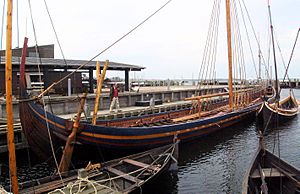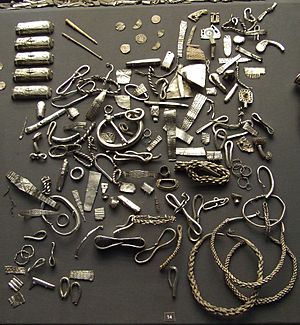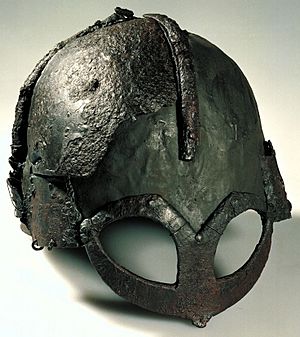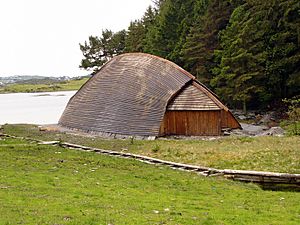Ivar of Limerick facts for kids
Quick facts for kids Ímar Luimnich |
|
|---|---|
| King of Hlymrek King of the Foreigners |
|
| Reign | c. 960 to 977 |
| Successor | Aralt mac Ímair (died 978) |
| Died | 977 Inis Cathaig |
| Issue | Amlaíb Cú Allaidh Dubcenn Aralt unknown daughter |
| House | Uí Ímair |
| Father | uncertain |
| Mother | unknown |
Ivar of Limerick (also known as Ímar Luimnich) was a powerful Viking leader in Ireland. He was the last Norse king of Limerick, a city-state in Munster. He lived during a time when the Dál gCais, a new powerful family led by Mathgamain mac Cennétig and later his famous brother Brian Bóruma, were rising to power. Ivar often fought against them, trying to keep control of Limerick and the surrounding areas.
Some old stories say Ivar ruled as King of Munster in the 960s. However, many historians doubt this claim. He was defeated in the Battle of Sulcoit in 968. But he seemed to return to the region soon after, trying to regain his power.
Contents
Learning About Ivar
Most of what we know about Ivar comes from two main sources. One is an old book called Cogad Gáedel re Gallaib (meaning "The War of the Irish with the Foreigners"). The other is the Annals of Inisfallen, which are like historical records.
The Cogad was written to make Brian Boru and his family look good. So, it might have some exaggerated stories. The Annals of Inisfallen are more like a simple record of events. However, they are missing some parts, so we don't have all the details about Ivar's life. Other sources exist, but they don't add much new information.
Ivar's Rule in Munster
Old texts describe Ivar's arrival and how he tried to control Munster. One passage says a huge fleet came with Ivar, who was called "chief king of the foreigners." He arrived with his three sons, Dubhcenn, Cú Allaidh, and Aralt. They landed in Limerick and began to take control of Munster.

The stories say Ivar set up a system of rule. He appointed kings and chiefs in every area. He also put officials and even soldiers in every house. This made life very difficult for the Irish people. They had to pay heavy taxes and give up their belongings.
Another old text describes this harsh rule:
A fleet, the like of which had never before been seen, came with Iomhar the Great [Íomhar Mór], grandson of Iomhar, chief king of the Foreigners, and with his three sons, viz. Duibhcenn, Cuallaidh, and Aralt, and they took Inis Sibthonn, in the harbour of Limerick, and they took hostages from the foreigners. The foreigners appointed a king over every territory, a chief over every tribe, an abbot over every church, a bailiff over every village, a soldier in every house, so that no Irishman had in his power, from the brood of a hen to the first milchcow, so that they did not dare to show devotion or care to father or to mother, to a bishop or to an ollav, or to a confessor, or to people who were ill or afflicted, or to an infant one night old; even if an Irishman had but one cow, the soup of her was forced to be given to the soldier, the night when milk could not be got from her, and an ounce of gold, or of silver, or of findruine as the royal rent for every year; and the man who had not the means (of paying it) had himself to go into slavery, or also his nose was cut off.
This account shows how strict Ivar's rule was. It suggests that the Norse were trying to take full control of parts of Munster. The Annals of Inisfallen also mention the "banishment of [Norse] soldiers from Munster" in 972. This happened because Irish leaders like Mathgamain and Máel Muad worked together to remove the Norse influence.
In 969, Ivar was mentioned in the annals for killing a king named Beólán Litil. This suggests Ivar and the Limerick Norse were active far from Limerick, even near Dublin. The Cogad says Ivar returned to Limerick from Britain with a new fleet before this event.
Limerick as a City-State
Historians believe that Norse cities like Limerick, Dublin, and Waterford were like independent city-states. This means they were cities that also acted as small countries, with their own rulers and laws. Limerick was a major trading center.
Limerick's economy likely involved trade with other parts of Europe. The taxes Ivar collected were similar to those in Dublin. This suggests the Norse controlled trade in their areas. The city of Limerick itself had streets during Ivar's time. This is mentioned in the Cogad when Mathgamain's army stormed the city.
Scattery Island, also known as Inis Cathaig, was probably part of Limerick's kingdom. Its Norse name might mean "tribute island," suggesting it paid taxes to Limerick. Ivar is mentioned on Scattery Island twice in the historical records.
Ivar's Capture and Escape
In 974, Ivar faced trouble. The Annals of Inisfallen say that "The son of Aralt made a circuit of Ireland with a great company, and plundered Inis Cathaig, and brought Ímar from it into captivity." This "son of Aralt" was Maccus mac Arailt, the King of Mann and the Isles.

It's not clear why Maccus captured Ivar. Perhaps Ivar had been driven out of Limerick and was hiding on Scattery Island. Or maybe they had a disagreement. Some historians think this event might be linked to Ivar's earlier adventures in Britain. Maccus and his brother Gofraid were likely sons of Aralt mac Sitric, an earlier king of Limerick. This could explain why Maccus was interested in the kingdom.
A year later, in 975, the Annals of Inisfallen report that "Ímar escaped over sea." This might mean he was released by Maccus or managed to get away. Some think he might have been ransomed for a large sum of silver.
Ivar's Role in Mathgamain's Downfall
In 976, Ivar played a part in a major event. He is said to have encouraged his ally, Donnubán mac Cathail, to betray Mathgamain. Mathgamain was the leader of the Dál gCais and a rival to Ivar. Donnubán invited Mathgamain to his house, which was a sign of submission. However, Mathgamain was then captured and handed over to Máel Muad mac Brain, who was another enemy. Máel Muad then had Mathgamain killed.
The historical records don't directly say Ivar was involved in this betrayal. However, the Cogad strongly suggests he was the one who planned it. This event weakened the Dál gCais and removed a major enemy for Ivar.
Ivar's Death and Legacy
In retaliation for Mathgamain's death, Brian Boru attacked Ivar in 977. Ivar and two of his sons, Amlaíb Cú Allaidh and Dubcenn, were killed on Scattery Island. This event marked the end of an independent Norse Limerick. The city had been a Viking stronghold for about 55 years.

At the time of his death, Ivar was called rí Gall, or "King of the Foreigners." This title was usually used for the Kings of Dublin, showing that Ivar was seen as a very important leader.
Ivar had another son named Aralt mac Ímair. Aralt was chosen as "King of the Foreigners of Munster" after his father's death. However, he was also killed by Brian's army in a battle, along with Donnubán.
Some modern families, like the O'Donovan family, claim to be descended from Ivar through a daughter. This daughter is said to have married his ally Donnubán.



